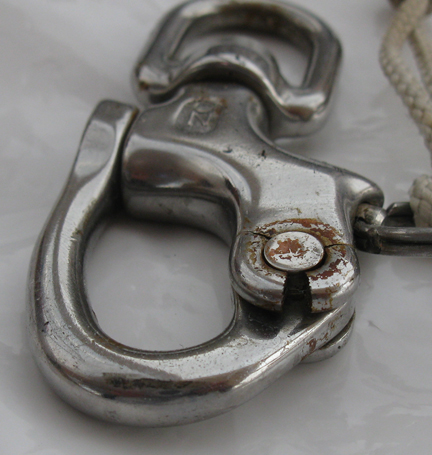Our upcoming report on passivating stainless steel brought to mind several past articles we’ve run on stainless steel failures. Although high-quality stainless can provide years of reliable service, sailors need to be aware of its limitations. As Derek Dudinsky, the owner of JTR Enterprises in Gulfport, Florida, put it, “Stainless steel, even 316-grade, is a terrible metal for marine use, but people like it because it’s shiny. In the old days, builders used silicon bronze—a much more sensible material—but it just became too expensive.”
Dudinsky, whose father and uncles fabricated stainless-steel fittings and hardware for southwest Florida boatbuilders throughout the sailing boom of the 1970s and early 80s, should know. His shop, still located in the same quiet corner of Gulfport, Florida where it has always been, no longer does mass production, but it is always busy with custom fabrication and repair work, and several shelves are crowded with broken stainless-steel hardware brought in by clients. Part of the reason the firm has endured so long is Dudinsky’s dedication to personal service. His website is the opposite of flash, a mere place-holder for “loyal customers who have lost our phone number.”
Owners of used boats with hardware of an unknown age should be especially scrupulous when carrying out routine inspection of stainless-steel rigging and hardware.
Small, load-bearing hardware such as shackles are particularly susceptible to failure after years of service. Shackles are among the most common products submitted to our hall of infamy, the Gear Graveyard, for reporting and/or analysis. Another common failure point is deck-level, swage-end fittings. The attached photo of an approximately 10-year-old Nicro snap shackle gives an example of what can happen when corrosion and cyclical loading take their toll on this common piece of hardware.

Crevice corrosion is probably one of the most virulent forms of corrosion that attack these small components. Any crack, seam, or flaw in the surface of the metal can become a fertile place for this type of corrosion to develop. All it takes is a small amount of oxygen-deficient salt water to become trapped in a tiny crevice, and the crevice becomes anodic, “sacrificing” electrons to the much larger surrounding cathodic surface area. Seemingly harmless rust stains are typical indicators of crevice corrosion, but the stains are not always obvious, sometimes hidden from view. Along with shackles and deck-level swage fittings, chainplates, turnbuckles, and any welds are also common sites for this and similar types of corrosion to develop.
Should you find signs of crevice corrosion, your course of action will depend on what is corroded and how serious the corrosion is. Regular, freshwater rinses, and keeping stainless steel micro-polished and passivated with citric acid can help prevent crevice corrosion, but some stainless-steel failures are often impossible to detect until it is too late. When in doubt, seek out the opinion of a local rigger. If you have recently purchased a used or new boat, having a rigger go over the rig, top-to-bottom can be worth the expense. It is a lot easier (and cheaper) to replace a suspect chainplate than deal with a broken mast at sea.
For more on stainless-steel corrosion, check out Marine Metal Warning,Used Stainless Steel Hardware, and the blog post What’s Hiding in Your Rig, and Cleaning Stainless Steel. You can also link to an interesting Gear Graveyard report on a different type of snap-shackle failure, available only as a PDF. That report is located in the “Also with this Article” box in our December 2009 Mailport.
Also look for our report on passivating stainless steel in the July 2020 issue. If you have a stainless-steel failure to report, email us at practicalsailor@belvoir.com.




































very good
Nice, concise and good info
Good article. It is fine to recycle articles (and you do display the original publication date), but perhaps you should update references to other articles? It is jarring to read “in the upcoming July 2020 article” references when you are posting this in May of 2021.
Input from a recovering sailor, now a power boater…
A chronically leaking rudder shaft seal on our Legacy 40 led to haulout and dropping the rudder to make a fix. We discovered a ring of very fine crevice corrosion where the Tides lip seal contacted the SS rudder post. No risk of a structural failure, but compromised the seal enough to leak. Near term fix was to install a new seal shimmed slightly above the ring of corrosion. Long term, we’ll monitor to see if we need to eventually replace the rudder shaft.
Best boatowner publication ever.
SS fittings are a minefield. Anything may break when under excessive load. But SS does it with not obvious reason. Over fifty years ago we had carbon steel cables with hand made splices. With time, when were tired individual wires broke and “lice” appeared, it was a signal that the shroud or the stay should be replaced before the next season. During last five years and 15,000 Nm I had five cases of breaking a shroud or stay just in the fixture edge. Crazy. The most unexpected was the breaking of the 20 mm axle rod of the wind van weighting maybe 2 kg. Now building a new boat I consider wide applying of aluminum, but can not see to many relevant info.